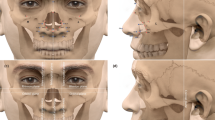Summary
INTRODUCTION: The craniofacial architecture is the result of a very complex interrelation. The nasal septum and specially vomer bone, because of its strategic spatial location between the cranial base and the mid-face, influence the growth of this area of the facial skeleton, thus playing a major role in the organization of the craniofacial architecture. The purpose was to analyze the influence of vomer bone on the morphology of the craniofacial architecture, evaluate its correlation with different structures, and compare the spatial position and dimensions between dentoskeletal frames. METHOD: 3D cephalometric measurements were analyzed and correlated in 302 digitally reconstructed skulls by 3D CBCT of a caucasic European adult population. RESULTS: Changes in the inclination and the dimensions of vomer bone were strongly correlated with other craniofacial structures. There were significant variations in vomer bone between the different dentoskeletal frames. CONCLUSIONS: Vomer bone seems to play an important role in the interrelation of the craniofacial architecture.
Similar content being viewed by others
References
Adam GL, Gansky SA, Miller AJ, Harrel WE Jr, Hatcher DC. Comparison between traditional 2-dimensional cephalometry and a 3-dimensional approach on human dry skulls. Am J Orthod Dentofacial Orthop 2004;126(4):397–409
Bacon W, Eiller V, Hildwein M, Dubois G. The cranial base in subjects with dental and skeletal Class II. Eur J Orthod 1992;14:224–8
Barteczko K, Jacob M. A re-evaluation of the premaxillary bone in humans. Anat Embryol 2004;207(6):417–37
Dhopatkar A, Bathia S, Rock P. An investigation into the relationship between the cranial base angle and malocclusion. Angle Orthod 2002;72:456–63
Dixon A, Hoyte D, Ronning O. Fundamentals of craniofacial growth. New York: CRC Press; 1997
Enlow D, Hans M. Essentials of facial growth. Philadelphia: WB Saunders Co; 1996
Friede H. The vomero-premaxillary suture – a neglected growth site in mid facial development of unilateral cleft lip and palate patients. Cleft Palate Craniofac J 1978;15(4):398–404
Friede H. Growth sites and growth mechanism at risk in cleft lip and palate. Acta Odont Scand 1998;56(6):346–51
Fushima K, Kitamra Y, Mita H, Sato S, Suzuki Y, Kim Y. Significance of the cant of the posterior occlusal plane in Class II Division 1 malocclusions. Eur J Orthod 1996;18:27–40
Hansen L, Nolting D, Holm G, Hansen B, Kjaer I. Abnormal vomer development in human fetuses with isolated cleft palate. Cleft Palate Craniofac J 2004;41(5):470–3
Hilloowala R. The transmission of masticatory forces and nasal septum: structural comparison of the human skull and gothic cathedral. Cranio 2007;25(3):166–71
Ho HD, Akimoto S, Sato S. Occlusal plane and mandibular posture in the hyperdivergent type of malocclusion in mixed dentition subjects. Bull Kanagawa Dent Coll 2002;30:87–92
Hopkin G, Houston W, James G. The cranial base as an etiological factor in malocclusion. Angle Orthod 1968;38:250–5
Jerolimov V, Keros J, Bagic I, Lazic B, Komar D. Vomer as a relevant factor in the mastication forces transmission system. Coll Antropol 1999;23(1):133–42
Kerr WJS, Adams CP. Cranial base and jaw relationships. Am J Anthrop 1988;77:213–20
Kim YH, Vietas J. Anteroposterior dysplasia indicator: An adjunct to cephalometric differential diagnosis. Am J Orthod 1978;73:619–33
Kimes K, Mooney M, Siegel M, Todhunter J. Growth rate of the vomer in normal and cleft lip and palate human fetal specimens. Cleft palate Craniofac J 1992;29(1):38–42
Klocke A, Nanda RS, Kahl-Nieke B. Role of cranial base flexure in developing sagittal jaw discrepancies. Am J Orthod Dentofacial Orthop 2002;122:386–91
Korbmacher H, Kahl-Nieke B, Schollchen M, Heiland M. Value of two cone-beam computed tomography systems from an orthodontic point of view. J Orofac Orthod 2007;68(4):278–89
Lagravere M, Carey J, Toogood R, Major PW. Three dimensional accuracy of measurements made with software on cone beam computed tomography images. Am J Orthod Dentofacial Orthop 2008;134:112–6
Latham R, Deaton T, Calabrese C. A question of the role of the vomer in the growth of the premaxillary segment. Cleft Palate 1975;12:351–5
Melsen B. Histological analysis of the postnatal development of the nasal septum. Angle 1977;47(2):83–96
Muramatsu A, et al. Reproducibility of maxillofacial anatomic landmarks on 3-dimensional computed tomographic images determined with the 95% confidence ellipse method. Angle Orthod 2008;78:396–402
Periago D, et al. Linear accuracy and reliability of cone beam CT derived 3-dimensional images constructed using an orthodontic volumetric rendering program. Angle Orthod 2008;78:387–95
Polat OO, Kaya B. Changes in cranial base morphology in different malocclusions. Orthod Craniofacial Res. 2007;10:216–21
Ricketts RM. Provocations and perceptions in craniofacial orthopedics: RMO; 1989
Sato S. Alteration of occlusal plane due to posterior discrepancy related to development of malocclusion-introduction to denture frame analysis. Bull Kanagawa Dent Coll 1987;15:115–23
Sato S, Takamoto K, Fushima K, Akimoto S, Suzuki Y. A new orthodontic approach to mandibular lateral displacement malocclusion: Dentistry in Japan; 1989
Sato S. A Treatment Approach to malocclusion under the consideration of craniofacial dynamics. Grace Printing Press Inc.; 2001
Slavicek R. The masticatory organ. Austria: Gamma Medizinisch-Wissenchaffliche Fortbildungs-AG; 2002
Squier C, Wada T, Ghoneim S, Kremenak C. A histological and ultrastructural study of wound healing after vomer resection in the beagle dog. Arch Oral Biol 1985;30(11–12):833–41
Tanaka E, Sato S. Longitudinal alteration of the occlusal plane and development of different dentoskeletal frames during growth. Am L Orthod Dentofacial Orthop 2008;134(5):602.e1–602.e11. (Online)
Van Vlijmen OJ, Berge SJ, Swennen GR. Comparison of cephalometric radiographs obtained from cone-beam computed tomography scans and conventional radiographs. J Oral Maxillofac Surg 2009;67(1):92–7
Wilhelm BM, Beck MF, Lidral AC, Vig KWL. A comparison of cranial base growth in Class I and Class II skeletal patterns. Am J Orthod Dentofacial Orthop 2001;119:401–5
Author information
Authors and Affiliations
Corresponding author
Rights and permissions
About this article
Cite this article
Basili, C., Otsuka, T., Kubota, M. et al. Three-dimensional CT analysis of vomer bone in the architecture of craniofacial structures in caucasic human skulls. J. Stomat. Occ. Med. 2, 191–204 (2009). https://doi.org/10.1007/s12548-009-0032-x
Received:
Accepted:
Published:
Issue Date:
DOI: https://doi.org/10.1007/s12548-009-0032-x




